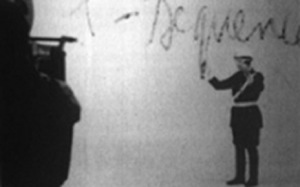Intitulé d’abord La Poubelle du labo, puis L’Enfer du cinéma, ce film, projeté pour la première fois en septembre 1968 à la Cinémathèque française, est l’homologue cinématographique des mots dans un sac de Tzara, ou mieux, une œuvre ressortissant de l’eshautomatisme isouien filmique. Il a été réalisé, en effet, à partir d’éléments de pellicule pêchés dans les poubelles d’un laboratoire de films, qui ont été joints bout à bout dans l’ordre même de récupération. Le son est celui qui se trouvait originellement sur la pellicule, ou il provient du passage de la partie d’image correspondant à la bande sonore devant le lecteur-son optique de l’appareil de projection. Ce son se trouve ainsi lui-même englobé dans la phase polyautomatique. De plus, le décalage habituel qui se trouve sur la copie standard entre l’image et le son (décalage nécessaire pour la projection synchrone) n’ayant pas été respecté ici, la bande sonore est ainsi, pour la première fois, semble-t-il, au cinéma, discrépante d’une manière spontanée. Si le résultat peut apparaître à certains spectateurs un peu éprouvant, je crois qu’il restera néanmoins dans l’Histoire du Film pour l’audace extrême qu’il représente et le style esthétique qu’il illustre, peut-être solitaire aujourd’hui.
This film, first titled La poubelle du labo (The Lab Trashcan), and after L'Enfer du cinéma (Cinema's Hell), has been projected for the very first time in September 1968 at the French Cinémathèque. It can be considered as the cinematographic equivalent of Tristan Tzara's method on how to make a dadaist poem by putting words in a bag, and it mostly rises from Isidore Isou's film enthusiasm. The film has been made in fact out of elements of film strips found in the trashcan of a film development laboratory, that have been subsequently taped together bit by bit following the exact order they were originally gathered.
The sound is the original one coming either from the different pieces of film strips, or from the passage of the image corresponding to the sound part of the strip in front of the optic sound reader of the projector. This sound thus finds itself encompassed in the so-called polyautomatic phase. Moreover, since the usual gap between the image and the sound (a necessary gap for any synchronized projection) that can be found on a standard film print hasn't been respected here, the sound is here, apparently for the first time in cinema history, spontaneously discrepant (in the meaning of Isou's lettrist cinema lexicon).
If the result may seem demanding to some in the audience, I think this piece will remain in Film History for its extreme audacity and for the aesthetic style it displays, quite a solitary one nowadays.
- Année
- 1968
- Nationalité
- France
- Durée
- 00:15:00
- Format de projection
- 16mm
